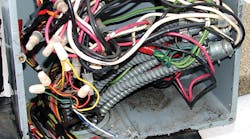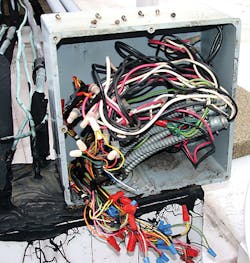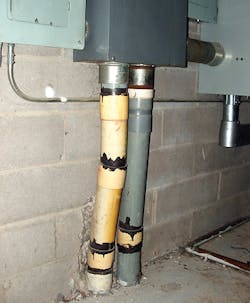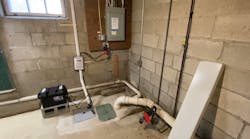Separation Anxiety
This PVC junction box contains power circuits and control circuits for several rooftop air-conditioning units. Unfortunately, the installer took some shortcuts, which created several Code violations.
The first problem is the improper way the MC and AC cables are terminated. Individual boxes should have been used for each set of cable splices in accordance with 300.15. A closer look also reveals improperly terminated equipment grounding conductors on the cable connector screws. Section 250.148 requires “devices suitable for the use” to be used for establishing continuity of equipment grounding conductors in junction boxes. The grounding and bonding continuity of these metal cables is extremely questionable.
The next violation is the lack of separation for the different types of circuits. Section 725.136(A) generally does not permit Class 2 control circuits to be placed in the same box with the power conductors. Section 725.136(B) does permit these different types of circuits to coexist if separated by a barrier. But as you can see in the photo, no barrier is present. Section 725.136(C) would allow the Class 2 circuits to be installed in a raceway within the enclosure in order to maintain separation. Alas, the installer ignored all those separation rules.
Flea Market Fittings
It appears as though this installer used whatever fittings he found at a flea market in order to complete this job. There are plumbing fittings, EMT fittings, GRC fittings, and PVC fittings all lumped together in this Rube Goldberg type installation.
Section 300.15 requires fittings and connectors to be “used only with the specific wiring methods for which they are designed and listed.” Set screw EMT connectors are certainly not designed and listed to be used for connecting PVC. The white plumbing fittings also are not designed to be used for electrical installations. As stated in 110.8, “Only wiring methods recognized as suitable” are permitted.” I’m not sure what type of glue was used for the PVC, but it seems like some kind of tar rather than a PVC solvent cement. It also appears as though some joints were not cemented (or tarred in this case) at all. Section 352.48 requires PVC joints to be made using only approved methods.
Perhaps the AHJ approved these types of connections, but my experience tells me otherwise. Even so, I think many inspectors would agree this installation was not done in a “neat and workmanlike manner,” as required by 110.12.






